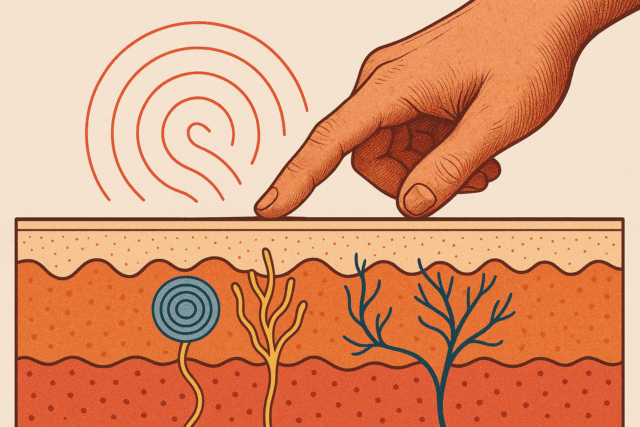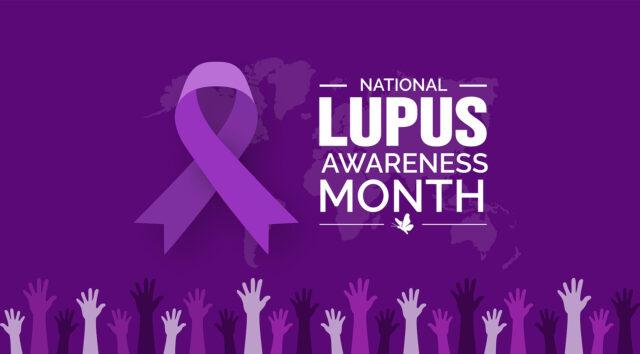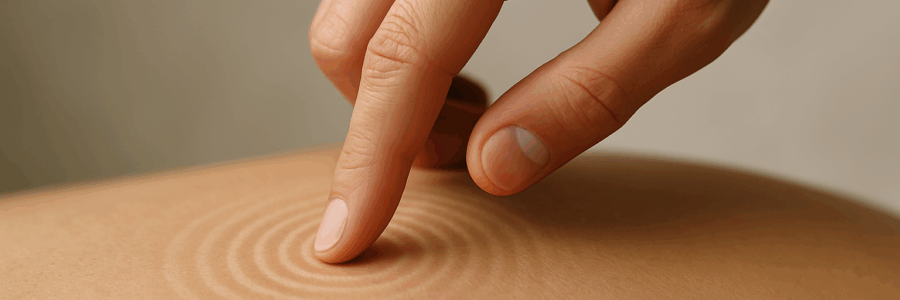 How Human Connection Begins with Skin-to-Skin Contact –
How Human Connection Begins with Skin-to-Skin Contact –
Touch is our first sense—the earliest to develop in the womb and the last to fade as we age. It connects us to the world, grounds us in our physical bodies, and shapes our emotional and social lives in profound ways. From a mother’s caress to a therapeutic massage, touch has the power to heal, soothe, and bond. But what does science say about this primal form of communication?
In this post, we’ll explore the science of touch: how it works, why it’s essential to our well-being, and how therapeutic touch (like massage therapy) taps into a deep biological system that benefits our bodies and minds.
1. The Biology of Touch: How the Body Feels
At the core of touch is our somatosensory system—a vast network of nerve endings, receptors, and brain regions that processes tactile information. This system can distinguish between pressure, temperature, texture, vibration, and pain.
Key Components:
-
Mechanoreceptors in the skin (like Merkel cells, Meissner’s corpuscles, and Pacinian corpuscles) detect different kinds of pressure and motion.
-
Thermoreceptors detect changes in temperature.
-
Nociceptors are sensitive to pain stimuli.
-
C-tactile afferents—a special class of nerves found primarily in hairy skin—respond specifically to gentle, slow touch, like a stroke or caress. They communicate not just sensation, but emotional context.
These signals are transmitted through the spinal cord to the brain, where areas like the somatosensory cortex and insula process them. The insula, in particular, links touch to emotion—highlighting that touch isn’t just a physical experience but a deeply emotional one
2. Touch and the Brain: Emotional Resonance and Hormonal Responses
One of the most fascinating aspects of touch is its ability to regulate emotions and physiology. A single hug or handhold can trigger a cascade of hormonal responses:
-
Oxytocin: Often dubbed the “love hormone,” oxytocin is released during affectionate touch. It promotes bonding, trust, and social connection.
-
Cortisol: Gentle touch has been shown to reduce levels of cortisol, the primary stress hormone.
-
Serotonin and dopamine: These feel-good neurotransmitters are also released, lifting mood and promoting a sense of well-being.
Functional MRI studies have shown that supportive touch reduces activity in the brain’s fear center (the amygdala) and increases activity in regions associated with reward and safety.
3. Developmental Importance: Why Babies Need Touch to Thrive
Touch is critical for early development. Infants who receive consistent, affectionate touch:
-
Gain weight more quickly
-
Cry less
-
Sleep better
-
Show better neurological development
Pioneering research in neonatal care has shown that “kangaroo care“ (skin-to-skin contact) between preterm infants and their parents improves survival rates and long-term health outcomes. The tactile experience provides comfort, regulates heart rate and temperature, and fosters bonding.
Conversely, children raised in environments with little physical contact (such as orphanages) often show signs of developmental delays, emotional detachment, and impaired cognitive function—a stark reminder of how essential touch is to human growth.
4. Therapeutic Touch: Massage, Healing, and Health
Massage therapy is a powerful application of intentional, structured touch—and its benefits are backed by decades of research.
Proven Benefits of Massage:
-
Pain Reduction: Particularly effective for chronic pain conditions like fibromyalgia, arthritis, and lower back pain.
-
Improved Circulation and Lymph Flow: Encourages blood flow and supports immune function.
-
Stress Relief: Regular massage reduces anxiety and promotes relaxation by decreasing cortisol and increasing serotonin.
-
Enhanced Sleep: Promotes deeper, more restorative rest.
-
Mental Health Support: Massage is increasingly recognized as a complementary therapy for depression, PTSD, and anxiety disorders.
Massage therapists leverage an intuitive understanding of the body’s need for safety, rhythm, and presence—activating the parasympathetic nervous system (the “rest and digest” state) and offering clients a path to self-regulation and healing.
5. Social Touch: The Glue of Human Relationships
We often underestimate the social and cultural power of touch. A handshake, a pat on the back, or a hug all convey messages that words sometimes can’t.
In couples, regular touch is linked to:
-
Greater relationship satisfaction
-
Reduced conflict
-
Increased intimacy and empathy
Even in professional settings, appropriate physical gestures like a reassuring touch can improve cooperation and morale.
However, cultural norms around touch vary significantly. What’s comforting in one context may be unwelcome in another. Understanding boundaries and consent is essential to respectful, healing touch.
6. The Crisis of Touch Deprivation
In our increasingly digital and socially distanced world, many people are experiencing touch deprivation. This can lead to:
-
Increased loneliness and depression
-
Heightened anxiety
-
A weakened immune system
This phenomenon, sometimes referred to as “skin hunger,” is a real biological need—our bodies crave contact, not just socially, but neurologically.
The pandemic further underscored how vital safe touch is to our well-being. In its absence, many turned to pets, self-massage tools, and therapeutic services to fulfill that need.
Conclusion: Touch as Medicine, Communication, and Connection
The science of touch reveals a simple truth: we are wired to connect through our skin. From infancy to old age, touch shapes who we are, how we heal, and how we relate to others. It’s more than a sensation—it’s a language, a medicine, and a vital part of what makes us human.
Whether you’re a parent, a caregiver, a therapist, or simply someone looking to better understand human connection, embracing the power of touch can open doors to empathy, healing, and deeper relationships.
Suggested Further Reading:
-
Touch: The Science of the Hand, Heart, and Mind by David J. Linden
-
The Body Keeps the Score by Bessel van der Kolk
-
Articles from the Touch Research Institute at the University of Miami
For more information visit our website: www.nw-academy.com

Enhancing Mental Health with Massage Therapy
 Introduction:
Introduction:
In today’s fast-paced and stress-filled world, finding effective ways to support our mental health is crucial. While many of us are aware of traditional methods like therapy and meditation, there’s one often underrated practice that holds immense potential in improving mental well-being: massage therapy. Beyond its reputation as a mere luxury or relaxation technique, massage offers a myriad of benefits that can profoundly impact our mental health. In this comprehensive blog post, we will delve into the profound effects of massage on mental well-being, exploring specific conditions and mechanisms through which massage therapy can enhance our mental health and overall quality of life.
Alleviating Stress and Anxiety:
Stress and anxiety have become all too common in our modern lives, but massage therapy can serve as a powerful antidote. Through the skillful manipulation of soft tissues and application of various techniques, massage promotes deep relaxation, allowing the body and mind to unwind. This process triggers the parasympathetic nervous system, reducing heart rate, blood pressure, and the production of stress hormones like cortisol. As a result, individuals experience a state of calm and tranquility, relieving the burdens of stress and anxiety.
Massage therapy has been the subject of numerous studies exploring its effects on stress and anxiety reduction. For instance, a study published in the Journal of Clinical Psychology demonstrated that massage therapy significantly decreased symptoms of anxiety and stress in individuals with generalized anxiety disorder. Another study published in the International Journal of Neuroscience found that massage therapy decreased cortisol levels while increasing levels of serotonin and dopamine, neurotransmitters associated with feelings of well-being and happiness.
Easing Symptoms of Depression:
Depression is a complex mental health condition that affects millions of people worldwide. Massage therapy can be a valuable complementary approach in managing and alleviating depressive symptoms. The nurturing touch and soothing movements of massage stimulate the release of endorphins, which are natural mood-elevating chemicals in the brain. Moreover, massage enhances the circulation of blood and lymph, facilitating the delivery of nutrients and oxygen to tissues while removing waste products, thus supporting the body’s natural healing processes. Regular massage sessions can contribute to improved mood, increased self-esteem, and a sense of overall well-being.
Research has shown promising results regarding the effects of massage therapy on depression. A meta-analysis published in the Journal of Clinical Psychiatry reviewed multiple studies and concluded that massage therapy significantly reduced symptoms of depression across various populations. The studies indicated that massage therapy improved overall mood, reduced feelings of sadness and hopelessness, and increased the sense of relaxation and well-being in individuals with depression.
Enhancing Sleep Quality:
Sleep plays a vital role in mental health, and massage therapy can significantly improve sleep quality. By reducing muscle tension, promoting relaxation, and lowering stress levels, massage creates an ideal environment for a restful sleep. The manipulation of soft tissues triggers the release of serotonin, a neurotransmitter associated with relaxation and sleep regulation. Additionally, massage stimulates the production of melatonin, a hormone that helps regulate sleep-wake cycles. These combined effects lead to more profound and uninterrupted sleep, allowing individuals to wake up feeling refreshed and mentally rejuvenated.
Several studies have explored the relationship between massage therapy and sleep quality. A study published in the Journal of Alternative and Complementary Medicine found that massage therapy improved sleep quality in postmenopausal women by reducing symptoms of insomnia and increasing sleep efficiency. Another study published in the Journal of Clinical Rheumatology reported that massage therapy improved both sleep quality and duration in individuals with fibromyalgia, a condition often characterized by sleep disturbances.
Cultivating Self-awareness and Mindfulness:
In our increasingly disconnected and fast-paced world, massage provides a unique opportunity to cultivate self-awareness and mindfulness. As the massage therapist’s skilled hands move across the body, individuals are encouraged to focus on physical sensations and engage in deep introspection. The meditative nature of massage helps individuals become more attuned to their bodies, emotions, and thoughts, fostering a sense of present-moment awareness. Through this process, massage can serve as a gateway to practicing mindfulness, both during the session and in everyday life, empowering individuals to manage stress, reduce rumination, and enhance overall emotional well-being.
Numerous studies have highlighted the link between massage therapy and mindfulness. A study published in the Journal of Bodywork and Movement Therapies found that individuals who received massage therapy reported increased mindfulness and a greater ability to connect with their bodies. The researchers suggested that massage therapy helped individuals become more present, enhancing body awareness and promoting a sense of overall well-being.
Facilitating Emotional Release and Healing:
Unresolved emotions and trauma can manifest as physical tension and discomfort within the body. Massage therapy can act as a catalyst for emotional release and healing. By applying targeted pressure and working on specific areas of the body, massage can release stored tension and facilitate the release of trapped emotions. This process provides individuals with a safe and supportive environment to acknowledge, process, and release emotional blockages. The emotional release experienced during massage can be cathartic, leading to a greater sense of emotional well-being, improved self-expression, and an increased capacity for resilience.
Research on the emotional benefits of massage therapy is growing. A study published in the Journal of Bodywork and Movement Therapies explored the experiences of individuals receiving massage therapy and found that it helped them connect with and release emotions stored within their bodies. Participants reported feeling lighter, more relaxed, and emotionally balanced following their sessions. Additionally, massage therapy has been integrated into trauma-informed care approaches, demonstrating its effectiveness in supporting trauma survivors in their healing journey.
Conclusion:
In a world where mental health concerns are increasingly prevalent, exploring holistic approaches to support our well-being is paramount. Massage therapy offers a transformative and natural method for improving mental health and enhancing overall quality of life. From alleviating stress and anxiety to easing symptoms of depression, enhancing sleep quality, cultivating self-awareness and mindfulness, and facilitating emotional release, the effects of massage extend far beyond relaxation. By incorporating massage into our self-care routines, we can unlock the transformative power it holds and take significant strides towards achieving optimal mental health.

Lupus & Massage Therapy
 Lupus, also known as Systemic Lupus Erythematosus (SLE), is a chronic autoimmune disease that can affect various parts of the body, including the skin, joints, kidneys, heart, and lungs. The condition occurs when the immune system mistakenly attacks healthy tissues in the body, causing inflammation and damage.
Lupus, also known as Systemic Lupus Erythematosus (SLE), is a chronic autoimmune disease that can affect various parts of the body, including the skin, joints, kidneys, heart, and lungs. The condition occurs when the immune system mistakenly attacks healthy tissues in the body, causing inflammation and damage.
While the exact cause of Lupus is unknown, it is believed to be a combination of genetic, environmental, and hormonal factors. Women are more likely to develop the condition than men, and it often appears between the ages of 15 and 44.
The symptoms of Lupus can vary widely, depending on which part of the body is affected. Common symptoms include fatigue, joint pain and stiffness, skin rashes, fever, hair loss, and chest pain. In some cases, Lupus can lead to more serious complications, such as kidney failure, heart attacks, and stroke.
There is currently no cure for Lupus, but treatment options are available to manage symptoms and prevent complications. These may include medications such as anti-inflammatory drugs, corticosteroids, and immunosuppressants, as well as lifestyle changes such as getting regular exercise, eating a healthy diet, and avoiding triggers that can worsen symptoms.
Massage therapy is one complementary therapy that may help people with Lupus manage their symptoms and improve their overall quality of life. Here are some of the ways that massage therapy can benefit patients with Lupus:
- Reducing Pain and Stiffness: Massage therapy can help reduce muscle and joint pain and stiffness, which are common symptoms of Lupus. Massage can help increase blood flow to the affected areas, promote the release of endorphins (natural painkillers), and reduce inflammation.
- Promoting Relaxation and Stress Relief: Stress can worsen symptoms of Lupus, and many people with Lupus experience anxiety and depression as a result of their condition. Massage therapy can help promote relaxation and reduce stress, which may help improve overall mental health.
- Improving Sleep: Many people with Lupus struggle with sleep disturbances, including insomnia and restless sleep. Massage therapy can help promote relaxation and improve sleep quality, which may help reduce fatigue and improve overall well-being.
- Boosting the Immune System: Massage therapy has been shown to stimulate the immune system and increase the production of white blood cells, which are responsible for fighting off infections. This can be particularly beneficial for people with Lupus, whose immune systems are compromised.
- Providing a Safe and Nurturing Environment: Many people with chronic illnesses such as Lupus may feel isolated or disconnected from others. Massage therapy provides a safe and nurturing environment where patients can feel cared for and supported, which can have a positive impact on their overall mental and emotional well-being.
It is important to note that massage therapy should not be used as a substitute for medical treatment for Lupus. However, it can be a valuable complementary therapy that can help improve symptoms and overall quality of life for people with Lupus.
If you are considering massage therapy as a treatment option for Lupus, be sure to talk to your healthcare provider first. They can help you determine if massage therapy is a safe and appropriate option for you, and can also recommend qualified massage therapists who have experience working with patients with Lupus.

Attend a Hybrid Massage Therapy Program!
 Massage therapy is a practice that involves the application of pressure, movement, and vibration to the soft tissues of the body. It has been used for thousands of years to relieve pain, promote relaxation, and improve overall health and well-being. Today, massage therapy is recognized as a valuable form of complementary medicine and is offered in a variety of settings, including spas, clinics, and hospitals.
Massage therapy is a practice that involves the application of pressure, movement, and vibration to the soft tissues of the body. It has been used for thousands of years to relieve pain, promote relaxation, and improve overall health and well-being. Today, massage therapy is recognized as a valuable form of complementary medicine and is offered in a variety of settings, including spas, clinics, and hospitals.
If you’re interested in pursuing a career in massage therapy, you may be considering attending a massage therapy program. However, with the advent of hybrid learning, you now have the option of attending a hybrid massage therapy program, which combines both online and in-person learning. In this blog post, we’ll explore the benefits of attending a hybrid massage therapy program in greater detail.
- Flexibility: One of the biggest benefits of a hybrid massage therapy program is flexibility. With a hybrid program, you have the flexibility to attend classes online or in-person. This means that you can tailor your learning experience to fit your schedule and preferences. For example, if you have a busy work schedule, you may choose to attend online classes during the week and in-person classes on the weekends. Alternatively, if you prefer to attend classes in-person, you can do so without having to commit to a full-time schedule.
- Convenience: Attending a hybrid massage therapy program also offers convenience. With online classes, you can learn from the comfort of your own home or any location that has an internet connection. This means that you can save time and money on commuting, parking, and other expenses associated with attending in-person classes. Online classes also allow you to learn at your own pace, which can be helpful if you need more time to absorb the material or have other commitments that take up your time.
- Personalization: Another benefit of a hybrid massage therapy program is personalization. With online classes, you can learn at your own pace and review materials as often as you need to. You can also communicate with your instructors and classmates through online forums and email, which can help you get personalized feedback and support. In-person classes also provide opportunities for personalized learning, as you can receive direct feedback from instructors and collaborate with other students in hands-on exercises.
- Hands-on experience: While online classes provide a great deal of flexibility and convenience, there is no substitute for hands-on experience. Attending in-person classes allows you to practice massage techniques on real clients under the supervision of experienced instructors. This gives you the opportunity to develop your skills and gain valuable experience in a real-world setting. In-person classes also provide opportunities to ask questions and receive feedback in real-time, which can be helpful for improving your technique and building your confidence.
- Cost-effective: A hybrid massage therapy program can provide significant cost savings for students. By attending online classes, students can save money on transportation costs, such as gas and parking fees, that are associated with commuting to and from school. Additionally, students can save money on other expenses, such as meals and childcare, that may be necessary when attending in-person classes. By attending online classes from the comfort of their own homes or other locations, students can avoid these additional costs and focus on their studies. Furthermore, hybrid programs often offer financial aid and scholarships that can help offset the cost of tuition. By taking advantage of these resources, students can make their massage therapy education more affordable and accessible. Overall, a hybrid massage therapy program provides a cost-effective way for students to pursue their career goals while saving money on the associated costs of attending school.
- Career readiness: Attending a hybrid massage therapy program can also help you prepare for a successful career in massage therapy. With a combination of online and in-person classes, you can develop a comprehensive understanding of massage techniques, anatomy, and physiology. You can also learn about business and marketing strategies that can help you build and grow your own massage therapy practice. In addition, attending a hybrid program can help you develop the soft skills that are essential for success in any career, such as communication, teamwork, and problem-solving.
- Networking opportunities: Finally, attending a hybrid massage therapy program provides opportunities for networking. In-person classes also provide opportunities to ask questions and receive feedback in real-time, which can be helpful for improving your technique and building your confidence. Additionally, attending in-person classes allows you to network with other students and instructors in the program. This can help you build connections in the massage therapy community and learn from experienced professionals.Attending a hybrid massage therapy program can also help you develop important soft skills that are essential for success in any career. Online classes require self-motivation, time management, and communication skills to succeed. These skills are highly valued by employers and can help you stand out in the job market. In-person classes provide opportunities for collaboration, teamwork, and leadership development, which are also highly valued by employers. By developing these skills in a hybrid program, you can become a well-rounded candidate for massage therapy jobs and other careers.
In conclusion, a hybrid massage therapy program offers a flexible, convenient, and personalized approach to learning that can help you achieve your career goals. By combining online and in-person classes, you can get the best of both worlds and develop a comprehensive understanding of massage techniques, anatomy, and physiology. You can also learn about business and marketing strategies that can help you build and grow your own massage therapy practice. With hands-on experience, cost savings, career readiness, networking opportunities, and the development of important soft skills, a hybrid massage therapy program can be an excellent investment in your future.





